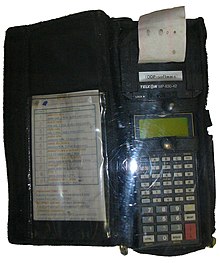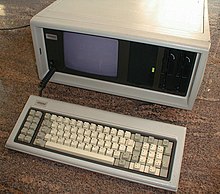Mobile computing
Template:Expert-subject-multiple
This article needs additional citations for verification. (July 2008) |

Mobile computing is a form of human–computer interaction by which a computer is expected to be transported during normal usage. Mobile computing has three aspects: mobile communication, mobile hardware, and mobile software. The first aspect addresses communication issues in ad-hoc and infrastructure networks as well as communication properties, protocols, data formats and concrete technologies. The second aspect is on the hardware, e.g., mobile devices or device components. The third aspect deals with the characteristics and requirements of mobile applications.
Definitions
Mobile computing is "taking a computer and all necessary files and software out into the field."[1]
"Mobile computing: being able to use a computing device even when being mobile and therefore changing location. Portability is one aspect of mobile computing."[2]
Devices
Many types of mobile computers have been introduced since the 1990s including the:
- Wearable computer
- Personal digital assistant/enterprise digital assistant
- Smartphone
- Carputer
- Ultra-Mobile PC
- Tablet computer
Limitations
- Insufficient bandwidth
Mobile Internet access is generally slower than direct cable connections, using technologies such as GPRS and EDGE, and more recently HSDPA and HSUPA 3G networks. These networks are usually available within range of commercial cell phone towers. Higher speed wireless LANs are inexpensive but have very limited range.
- Security standards
When working mobile one is dependent on public networks, requiring careful use of VPN. Security is a major concern while concering the mobile computing standards on the fleet. One can easily attack the VPN for a very huge number of networks interconnected through the line.
- Power consumption
When a power outlet or portable generator is not available, mobile computers must rely entirely on battery power. Combined with the compact size of many mobile devices, this often means unusually expensive batteries must be used to obtain the necessary battery life.
- Transmission interferences
Weather, terrain, and the range from the nearest signal point can all interfere with signal reception. Reception in tunnels, some buildings, and rural areas is often poor.
- Potential health hazards
More car accidents are related to drivers who communicate with mobile devices. Cell phones may interfere with sensitive medical devices. There are allegations that cell phone signals may cause health problems. [citation needed]
- Human interface with device
Screens and keyboards tend to be small, which may make them hard to use. Alternate input methods such as speech or handwriting recognition require training.
In-vehicle computing and fleet computing
Many commercial and government field forces deploy a ruggedized portable computer such as the Panasonic Toughbook or larger rack-mounted computers with their fleet of vehicles. This requires the units to be anchored to the vehicle for driver safety, device security, and ergonomics. Ruggedized computers are rated for severe vibration associated with large service vehicles and off-road driving and the harsh environmental conditions of constant professional use such as in emergency medical services, fire, and public safety.

Other elements that enables the unit to function in vehicle:
- Operating temperature: A vehicle cabin can often experience temperature swings from -20F to +140F. Computers typically must be able to withstand these temperatures while operating. Typical fan based cooling has stated limits of 95F-100F of ambient temperature, and temperature below freezing require localized heaters to bring components up to operating temperature(based on independent studies by the SRI Group and by Panasonic R&D).
- Vibration: Vehicles typically have considerable vibration that can decrease life expectancy of computer components, notably rotational storage such as HDDs.
- Daylight, or sunlight readability: Visibility of standard screens becomes an issue in bright sunlight.
- Touchscreens: These enable users to easily interact with the units in the field without removing gloves.
- High-temperature battery settings:. Lithium ion batteries are sensitive to high temperature conditions for charging. A computer designed for the mobile environment should be designed with a high-temperature charging function that limits the charge to 85% or less of capacity.
- External wireless connections, and external GPS antenna connections: Necessary to contend with the typical metal cabins of vehicles and their impact on wireless reception, and to take advantage of much more capable external tranception equipment.
Several specialized manufacturers such as First Mobile Technologies, National Products Inc (Ram Mounts), Gamber Johnson and LedCo build mounts for vehicle mounting of computer equipment for a wide range of vehicles. The mounts are built to withstand the harsh conditions and maintain ergonomics.
Specialized installation companies specialize in designing the mount design, assembling the parts, and installing them in a safe and consistent manner away from airbags, vehicle HVAC controls, and driver controls. Frequently installations will include a WWAN modem, power conditioning equipment, and WWAN/WLAN/GPS/etc. Transceiver antennæ mounted external to the vehicle. Mobile internet access is generally slower than direct cable connections, using technologies such as general packet radio service (GPRS) and Enhanced Data for GSM Evolution (EDGE), and more recently 3G networks. These networks are usually available within range of commercial cell phone towers. Higher speed wireless LANs are inexpensive, but have very limited range
Portable computing devices
There are several categories of portable computing devices that can run on batteries but are not usually classified as laptops: portable computers, keyboardless tablet PCs, Internet tablets, PDAs, ultra mobile PCs (UMPCs) and smartphones.

A portable computer is a general-purpose computer that can be easily moved from place to place, but cannot be used while in transit, usually because it requires some "setting-up" and an AC power source. The most famous example is the Osborne 1. Portable computers are also called a "transportable" or a "luggable" PC.
A tablet PC that lacks a keyboard (also known as a non-convertible tablet PC) is shaped like slate or a paper notebook, features a touchscreen with a stylus and handwriting recognition software. Tablets may not be best suited for applications requiring a physical keyboard for typing, but are otherwise capable of carrying out most tasks that an ordinary laptop would be able to perform.
An Internet tablet is an Internet appliance in tablet form. Unlike a tablet PC, an Internet tablet does not have much computing power and its applications suite is limited, and it can not replace a general purpose computer. Internet tablets typically feature an MP3 and video player, a web browser, a chat application and a picture viewer.
A personal digital assistant (PDA) is a small, usually pocket-sized, computer with limited functionality. It is intended to supplement and to synchronize with a desktop computer, giving access to contacts, address book, notes, e-mail and other features.

An ultra mobile PC is a full-featured, PDA-sized computer running a general-purpose operating system.
A smart phone is a PDA with an integrated cellphone functionality. Current smartphones have a wide range of features and installable applications.
A carputer is a computing device installed in an automobile. It operates as a wireless computer, sound system, GPS, and DVD player. It also contains word processing software and is bluetooth compatible.[3]
A Fly Fusion Pentop computer is a computing device the size and shape of a pen. It functions as a writing utensil, MP3 player, language translator, digital storage device, and calculator.[4]
Boundaries that separate these categories are blurry at times. For example, the OQO UMPC is also a PDA-sized tablet PC; the Apple eMate had the clamshell form factor of a laptop, but ran PDA software. The HP Omnibook line of laptops included some devices small enough to be called ultra mobile PCs. The hardware of the Nokia 770 internet tablet is essentially the same as that of a PDA such as the Zaurus 6000; the only reason it's not called a PDA is that it does not have PIM software. On the other hand, both the 770 and the Zaurus can run some desktop Linux software, usually with modifications.
See also
- Enterprise digital assistant
- Location-based service
- Mobile ad-hoc networks
- Mobile Computing and Communications Review
- Mobile development
- Mobile device management
- Mobile identity management
- Mobile software
- Mobileers (users of mobile rigs)
- Ubiquitous computing
References
- GH Forman, J Zahorjan - Computer, 1994 - doi.ieeecomputersociety.org
- David P. Helmbold, "A dynamic disk spin-down technique for mobile computing", citeseer.ist.psu.edu, 1996
- MH Repacholi, "health risks from the use of mobile phones", Toxicology Letters, 2001 - Elsevier
- Landay, J.A. Kaufmann, T.R., "user interface issues in mobile computing", Workstation Operating Systems, 1993.
- T Imielinski, BR Badrinath "mobile wireless computing, challenges in data management- Communications of the ACM, 1994 - portal.acm.org
- Roth, J. "Mobile Computing - Grundlagen, Technik, Konzepte", 2005, dpunkt.verlag, Germany
Further reading
- B'Far, Reza (2004). Mobile Computing Principles: Designing and Developing Mobile Applications with UML and XML. Cambridge University Press. ISBN 0521817331.
- Poslad, Stefan (2009). Ubiquitous Computing: Smart Devices, Environments and Interactions. Wiley. ISBN 0470035609.
- Rhoton, John (2001). The Wireless Internet Explained. Digital Press. ISBN 1555582575.
- Talukder, Asoke; Yavagal, Roopa (2006). Mobile Computing: Technology, Applications, and Service Creation. McGraw-Hill Professional. ISBN 0071477330.
